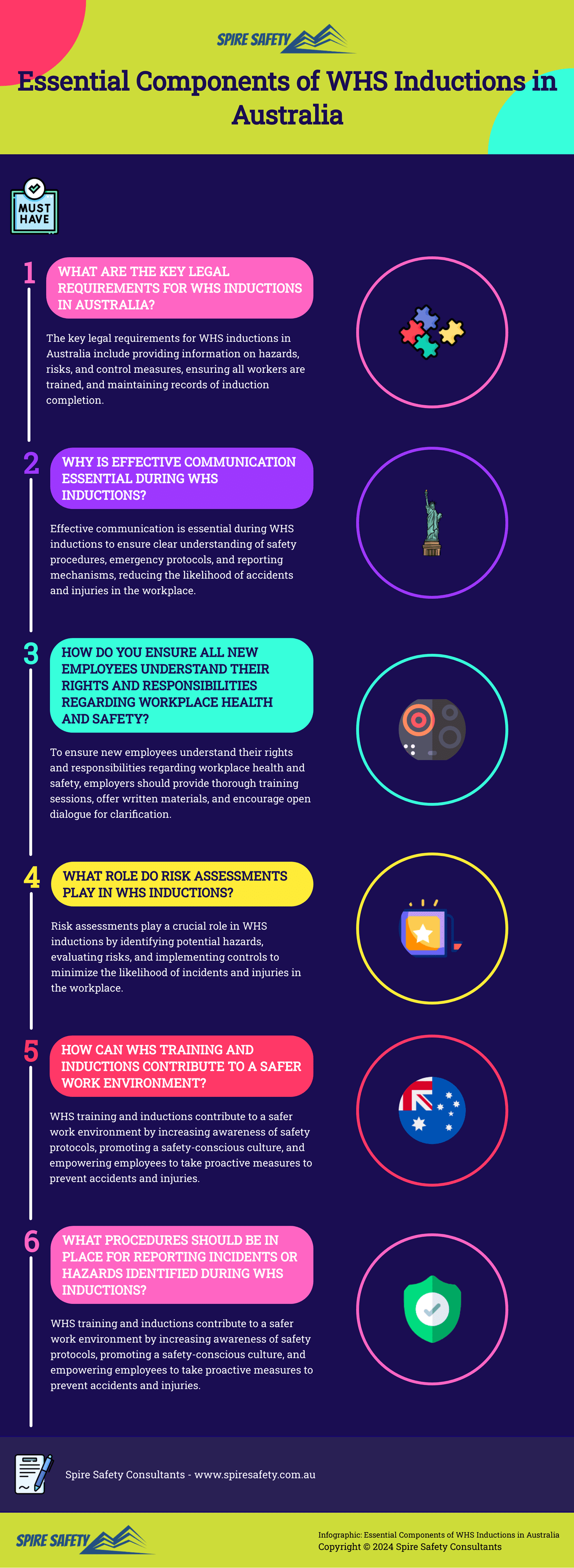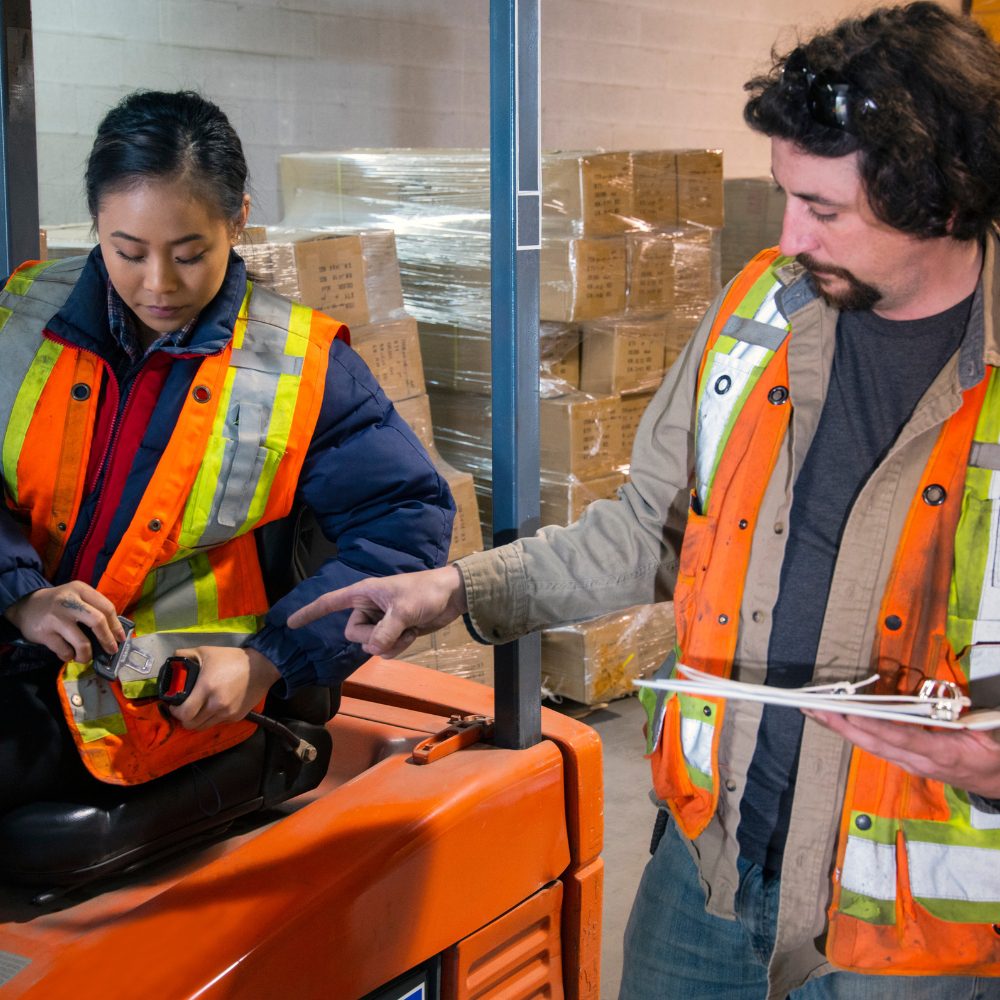The implementation of Work Health and Safety (WHS) induction programs is a pivotal step in fostering a positive safety culture within Australian organisations.
These programs serve as an essential bridge, introducing new employees to the core values, policies and procedures related to workplace health and safety.
A comprehensive WHS induction not only covers the broad spectrum of health and safety issues but also delineates the responsibilities of both employers and employees towards maintaining a safe working environment.
Central to these inductions are the details concerning the identification and management of hazards and risks, alongside the organisation’s protocols for reporting incidents.
Induction programs are meticulously designed to encompass risk management procedures, emergency responses, and first aid measures – all tailored to mitigate workplace accidents and ensure swift, organized reactions to unforeseen events.
Moreover, the role of WHS training within these inductions cannot be overstated. It equips employees with the necessary knowledge and skills to navigate the workplace safely, thereby significantly reducing the likelihood of accidents.
The Health and Safety Act 2011 underpins these efforts, providing a legal framework that mandates the incorporation of these elements into induction programs.
Ultimately, the goal of WHS inductions is to embed a robust safety culture within the organisation.
By systematically addressing workplace health and safety from the onset, employers can lay the groundwork for a safety-conscious mindset among their workforce, thereby fostering an environment where safety is not just regulated but inherently valued.
Understanding the Significance of WHS Inductions
WHS inductions play a critical role in the assimilation of new employees into an organisation’s culture and operational procedures, particularly with regard to safety. These inductions are not just about compliance; they are a fundamental component in the development of a proactive safety culture that prioritises the well-being of every individual within the workplace. By integrating WHS training from the beginning, employers demonstrate their commitment to safety, setting the tone for what is expected and accepted within the organisation.
Through the detailed exposition of health and safety issues, hazards and risks, and the policies and procedures in place to manage them, inductions serve as a comprehensive guide for new hires. They outline not only the practical steps for reporting and managing incidents but also underscore the shared responsibility of employers and employees in upholding workplace safety. This mutual understanding is pivotal in cultivating a collaborative environment where safety is everyone’s concern.

Furthermore, the Health and Safety Act 2011 provides a legal backdrop that reinforces the importance of these inductions. It mandates employers to ensure that their workforce is well informed and trained on safety matters pertinent to their roles. This legal obligation underscores the significance of WHS inductions not just from a compliance standpoint but as a crucial element in safeguarding the health and welfare of employees.
In essence, WHS inductions are instrumental in laying the foundational knowledge and attitudes towards safety that new employees carry throughout their tenure. These programs are an investment in the workforce’s safety and well-being, evidencing an organisation’s dedication to not just meeting legal requirements but exceeding them, in pursuit of a genuinely safe, healthful working environment.
The Role of Inductions in Minimising Workplace Risks
Inductions serve as a critical tool in the minimisation of workplace risks, particularly for new employees who are statistically more vulnerable to accidents and injuries. By systematically introducing new hires to the specific processes, equipment, and safety protocols of the workplace, inductions significantly reduce the likelihood of mishaps. This proactive approach to safety training ensures that employees are not left to navigate the complexities of their new environment unaided.
Moreover, these induction programs provide a platform for employers to communicate their safety expectations clearly and thoroughly. By outlining the correct procedures for reporting hazards and risks, inductions empower employees to contribute to the safety of their workplace actively. This engagement fosters a sense of responsibility among new hires, encouraging them to be vigilant and proactive in identifying potential safety issues.
In addition, the support and guidance offered through these inductions are instrumental in building confidence among new workers. This confidence, rooted in a clear understanding of workplace safety protocols and emergency procedures, is crucial in preventing accidents. Inductions, therefore, not only serve to protect employees but also mitigate the potential financial and reputational damages associated with workplace injuries for employers.
Specific Challenges in the Manufacturing and Construction Industries
The manufacturing and construction industries face unique challenges that underscore the importance of comprehensive WHS inductions. Given the inherently higher risks associated with these sectors, including the operation of heavy machinery, exposure to hazardous materials, and the execution of high-risk tasks, inductions must be meticulously tailored to address these industry-specific hazards. This tailored approach ensures that employees are equipped with the knowledge and skills necessary to navigate their work environment safely.
Additionally, the dynamic nature of construction and manufacturing sites, where conditions and potential hazards can change daily, necessitates a flexible yet thorough induction process. Employees must be trained to adapt to these evolving environments, recognizing and responding to new risks as they arise. This adaptability is crucial in maintaining a safe workplace amidst the complexities of these industries.
Lastly, the high turnover rate often seen in these sectors amplifies the need for effective and efficient induction programs. With new workers frequently entering the workforce, the ability to quickly assimilate and educate them on safety practices becomes a vital component of an organisation’s overall safety strategy. Thus, the role of inductions in these industries extends beyond initial training, contributing to a continuous culture of safety awareness and vigilance.
The Legal Framework Surrounding Employer Responsibilities
The legal framework in Australia, particularly the Health and Safety Act 2011, establishes clear mandates for employers regarding workplace safety. This legislation underscores the necessity of providing effective inductions, training, and information to all workers, especially those new to the task or workplace. Inductions serve as the primary vehicle through which employers can fulfil these obligations, detailing the workplace’s health and safety policies, emergency procedures, and the roles of health and safety representatives.
An induction checklist becomes an invaluable tool in this context, ensuring that no aspect of safety training is overlooked. This checklist aids employers in covering all necessary topics, from identifying hazards and risks specific to the workplace to explaining the safe work procedures applicable to the employee’s tasks. By adhering to this structured approach, employers can demonstrate their commitment to safety leadership and the prevention of workplace accidents.
Furthermore, the legal framework highlights the vulnerability of young workers to workplace hazards, making their effective induction even more critical. By specifying the rights and responsibilities of all parties involved and outlining the proper channels for reporting health and safety concerns, the law aims to protect these at-risk groups. This protection is not only a matter of legal compliance but a fundamental aspect of ethical employer conduct.
Ultimately, by integrating these legal requirements into their WHS inductions, employers not only ensure compliance but also lay the groundwork for a culture of safety and prevention. This proactive approach to safety management, guided by both legal obligations and ethical considerations, fosters a workplace environment where safety is prioritized, and every employee is empowered to contribute to the collective well-being.
Ensuring Compliance and Enhancing Safety Culture
Ensuring compliance with the Health and Safety Act 2011 is a fundamental aspect of WHS inductions, serving as a baseline from which to build a more comprehensive safety culture. Through detailed inductions, employers can effectively communicate the importance of safety rules, the procedures for emergency situations, and the protocols for reporting hazards. This communication is essential not only for meeting legal standards but for ingraining safety as a core value within the organisation.
Moreover, the role of safety leadership in enhancing this culture cannot be overstated. Leaders who actively participate in and advocate for safety training and inductions set a powerful example for their employees. This leadership fosters an environment where safety is seen as a collective responsibility, encouraging all employees to take an active role in maintaining a safe workplace. Such an environment not only complies with legal requirements but exceeds them, creating a workspace where safety is inherently valued and continuously improved upon.
Ultimately, the goal of WHS inductions is not just to inform but to transform. By integrating safety into the fabric of the organisation’s culture, employers can cultivate a workplace where safety compliance is a given and enhancing the safety culture is an ongoing journey. This commitment to safety, underscored by effective inductions and strong safety leadership, lays the foundation for a resilient, health-conscious organisation.
Constructing Effective WHS Induction Programs
Creating effective Work Health and Safety (WHS) induction programs is pivotal in fostering a safety culture within Australian workplaces. These programs serve not only as an introductory platform for new employees to understand their roles within the safety management system but also reinforce the importance of workplace health and safety practices among existing staff. A well-constructed induction program underlines the employer’s commitment to safety and compliance with the Health and Safety Act 2011, setting the tone for safety practices within the organisation.
At the core of these programs are the policies and procedures that govern workplace operations, ensuring that every employee, regardless of their position, understands their health and safety responsibilities. The induction programs must address a wide array of health and safety issues, including but not limited to, risk management procedures, reporting incidents and hazards, and emergency and first aid procedures. This comprehensive approach ensures that employees are well-equipped to contribute positively to the workplace’s safety culture from day one.
The construction and manufacturing industries, known for their high-risk environments, demand even more specific and detailed induction programs. Tailoring these programs to address the unique challenges and safety risks of these industries is crucial. By including site-specific safety protocols and procedures, employers can significantly minimise workplace risks and enhance overall safety outcomes.
Lastly, the effectiveness of a WHS induction program is dependent on its delivery and implementation. Utilising technology and innovative engagement strategies can greatly enhance the learning experience, making safety inductions more interactive and impactful. Employers must continuously seek ways to improve their induction programs, ensuring they remain relevant and effective in promoting a culture of safety and compliance.
Core Elements to Include in Every Induction
An effective WHS induction program is characterised by its comprehensive coverage of essential safety management elements. At the forefront are the safe work practices that every employee must adopt to maintain a safe working environment. These practices form the backbone of a company’s safety culture, ensuring that every team member, from new hires to seasoned workers, understands their role in upholding workplace safety.
Another vital component of every induction program is the clear communication of the organisation’s safety policies and procedures. This not only helps in setting clear expectations for conduct within the workplace but also ensures that all employees are aware of the mechanisms in place for reporting incidents and hazards. Understanding these procedures is crucial for the swift and effective management of safety issues, thereby minimising risks and enhancing overall safety.
Additionally, an induction must include a thorough overview of the Health and Safety Act 2011, educating employees on their legal obligations and rights concerning workplace health and safety. Such knowledge empowers employees, fostering a proactive approach to safety and compliance. Moreover, it underscores the employer’s commitment to not just meeting but exceeding statutory safety requirements.
Lastly, every induction should detail the specific risk management strategies employed by the organisation to mitigate workplace hazards. This includes identifying potential risks, implementing preventive measures, and establishing emergency response procedures. By comprehensively covering these core elements, an induction program can significantly contribute to the development of a robust and proactive safety culture within the workplace.
Site-Specific Safety Protocols and Procedures
In industries such as construction and manufacturing, where the nature of work significantly increases exposure to safety risks, site-specific safety protocols and procedures are indispensable. These tailored measures take into account the unique characteristics and hazards of each work site, offering detailed guidance on mitigating risks specific to that environment. For instance, construction sites require stringent protocols around the use of heavy machinery and equipment, highlighting the importance of personal protective equipment (PPE) and the safe operation of machinery.
Beyond general safety practices, these protocols also address site-specific emergency response procedures. Given the varying nature of potential incidents across different sites, custom emergency plans ensure that employees are adequately prepared to respond effectively in case of an emergency. This includes specific evacuation routes, designated assembly points, and the location of first aid facilities.
Integrating these site-specific safety protocols and procedures into WHS induction programs not only enhances the safety and well-being of employees but also demonstrates an employer’s commitment to creating a safe working environment. By addressing the particular risks associated with each site, employers can significantly reduce the likelihood of accidents and injuries, fostering a culture of safety that permeates every aspect of the workplace.
Utilising Technology for Engaging Inductions
The adoption of technology in delivering WHS induction programs has revolutionised the way organisations approach workplace health and safety training. Digital platforms and e-learning tools offer interactive and engaging ways to present complex safety information, making it more accessible and understandable for employees. This technological approach allows for the customization of content to suit diverse learning styles, ensuring that all employees, regardless of their background or skill level, can effectively grasp important safety concepts.
Moreover, the use of technology in inductions facilitates real-time updates and the dissemination of information, keeping the content relevant and up-to-date with the latest health and safety regulations and practices. This is particularly important in dynamic industries where safety standards and regulations frequently evolve. By leveraging digital platforms, employers can swiftly incorporate changes into their induction programs, ensuring employees always have access to the most current safety information.
Interactive simulations and virtual reality (VR) are also becoming increasingly popular in WHS inductions, especially in industries like construction and manufacturing where realistic scenarios can significantly enhance understanding and retention of safety practices. These technologies allow employees to experience and navigate potential hazards in a controlled, virtual environment, preparing them for real-life situations without the associated risks.
Finally, the integration of mobile applications and online platforms in WHS inductions offers unparalleled flexibility, allowing employees to access training materials anytime and anywhere. This not only accommodates diverse schedules and learning paces but also reinforces a culture of continuous learning and safety awareness outside the traditional induction setting. Through the strategic use of technology, organisations can create more effective, engaging, and accessible WHS induction programs that resonate with the modern workforce.
The Advent of Health Maintenance Tools as Apps
The emergence of health maintenance tools as apps mark a significant advancement in workplace health and safety management, particularly in the construction industry. These apps offer an innovative approach to safety management, allowing employees to access a wealth of health and safety resources directly from their mobile devices. From real-time hazard reporting to interactive safety training modules, these tools empower workers to take an active role in maintaining a safe work environment.
Furthermore, these apps facilitate the tracking and monitoring of health and safety metrics, enabling both employees and employers to identify trends and areas for improvement. This data-driven approach to safety management supports the development of targeted interventions, enhancing the overall effectiveness of safety programs. In the construction industry, where the work environment is constantly changing, the ability to rapidly disseminate safety updates and alerts through mobile apps is invaluable.
By integrating health maintenance tools into safety management practices, employers can foster a more proactive and preventive safety culture. These apps not only provide immediate access to critical safety information but also encourage ongoing engagement with safety practices, making them a key component in the modern landscape of workplace health and safety.
Special Considerations for Young and New Workers
Young and new workers present a distinct demographic in the workforce, each with its unique challenges and needs in terms of Workplace Health and Safety (WHS) inductions. Recognizing these challenges is pivotal to creating a safe workplace that nurtures their development and ensures their protection. This demographic, often venturing into the workforce for the first time, may lack the experience and awareness necessary to navigate the complexities of WHS, making them particularly vulnerable to workplace hazards.
These workers may possess an eagerness to impress, coupled with a reluctance to question or raise concerns, potentially placing them at greater risk. The dynamism of their youthful perspective, while valuable, may also lead to overconfidence in their abilities to manage risks, sometimes overlooking the need for stringent control measures. Their developmental stage may not always equip them with the maturity required to make informed decisions about their safety and the safety of others in the workplace.
Therefore, addressing the unique risks faced by young and new workers through targeted WHS inductions can significantly mitigate these risks. By tailoring induction programs to meet their specific needs, employers can foster a culture of safety that resonates with this group, encouraging active participation and dialogue. This approach not only enhances the efficacy of WHS inductions but also contributes to the cultivation of a safe workplace culture that values and protects its most vulnerable members.
Ultimately, the goal is to ensure that these young and new members of the workforce are not only aware of their WHS responsibilities but are also equipped with the knowledge and skills to contribute to a safe workplace. By prioritizing their unique needs within WHS inductions, employers can significantly reduce the incidence of workplace injuries among this demographic, ensuring a safer, more inclusive work environment for all.
Addressing the Unique Risks Faced by Young Workers
Young workers, characterized by their limited work experience and nascent awareness of WHS risks, face unique challenges in the workplace. Their enthusiasm to make a positive impression can sometimes eclipse their judgment regarding safety, leading to potentially hazardous situations. This demographic’s tendency towards overconfidence in their capabilities without a commensurate understanding of the risks involved necessitates a tailored approach to WHS inductions.
Their relative inexperience not only makes them less familiar with the necessary control measures for ensuring a safe workplace but also may hinder their ability to make mature decisions about their safety and the safety of others. This scenario underscores the critical need for WHS inductions that are specifically designed to address the unique needs and challenges of young workers, educating them on the importance of safety protocols and empowering them to take proactive steps in maintaining a safe working environment.
Moreover, young workers may be reticent to voice concerns, ask questions, or highlight potential risks, often due to a fear of criticism or a desire to prove their capabilities. Effective WHS inductions must, therefore, foster an environment where young workers feel valued and encouraged to actively participate in discussions about safety. This approach not only enhances their understanding and application of safety practices but also instills a sense of responsibility and ownership over their work environment.
To create a truly safe workplace, it is imperative that WHS inductions for young workers include comprehensive guidance on recognizing hazards, understanding and implementing control measures, and cultivating a culture of safety. By addressing the unique risks faced by young workers in a manner that resonates with them, employers can significantly enhance the efficacy of WHS inductions, contributing to a safer, more inclusive workplace for all.
Partnering with Educational Institutions for Enhanced Safety Awareness
One innovative approach to enhancing WHS awareness among young workers involves forging partnerships with educational institutions. These collaborations can facilitate the introduction of WHS principles early in the educational journey, preparing students for the realities of the workplace even before they enter it. By integrating WHS education into curricula, students can gain a foundational understanding of safety protocols and the importance of a safe workplace, setting the stage for more effective inductions once they begin their professional careers.
Such partnerships not only benefit students but also provide employers with a workforce that is already primed with basic WHS knowledge. This foundation can greatly enhance the effectiveness of subsequent WHS inductions, as young workers come equipped with an understanding of safety concepts and the significance of control measures. Educational institutions, in turn, can offer tailored programs that align with the specific needs of various industries, ensuring that students are not only aware of general WHS principles but also of the unique challenges and safety requirements of their chosen fields.
The synergy between educational institutions and the workforce in promoting WHS awareness underscores the potential for a proactive approach to safety education. By engaging young workers in meaningful WHS learning experiences before they enter the workforce, the transition to workplace safety culture can be seamless, fostering a generation of workers who prioritize safety from the outset of their careers.
Strategies for Effective Induction of Young Workers
Developing effective WHS induction programs for young workers requires a nuanced understanding of their learning preferences and the unique risks they face in the workplace. Strategies that emphasize engagement, relatability, and practical application are key to ensuring that these inductions resonate with young workers and equip them with the necessary tools to maintain a safe workplace. Tailoring content to be both informative and interactive can help bridge the gap between theoretical knowledge and practical application, making safety protocols more accessible and understandable.
Incorporation of real-life scenarios and hands-on training within inductions can significantly enhance the learning experience, providing young workers with a tangible understanding of how safety protocols apply in everyday work situations. This approach not only aids in the retention of critical safety information but also empowers young workers to confidently navigate their work environment, armed with the knowledge to identify and mitigate potential hazards.
Moreover, leveraging technology in the delivery of WHS inductions can further enhance engagement and learning outcomes. Digital platforms and tools offer an interactive and dynamic medium for conveying safety information, appealing to the tech-savvy nature of younger demographics. Through the use of apps, online modules, and virtual reality simulations, young workers can explore various safety scenarios in a controlled, risk-free environment, fostering a deeper understanding of safety practices and their importance.
Ultimately, the goal of any WHS induction program for young workers should be to foster a culture of safety that values proactive risk management and open communication. By adopting strategies that prioritize engagement, practical application, and the use of technology, employers can ensure that young workers are not only well-informed about safety protocols but are also motivated to contribute to a safe workplace environment.
Interactive and Youth-Focused Learning Approaches
Interactive and youth-focused learning approaches stand at the forefront of effective WHS induction strategies for young workers. Utilizing interactive learning methods, such as gamification and scenario-based training, can significantly increase engagement and comprehension. These methods transform learning about safety from a passive to an active process, encouraging young workers to participate fully in their WHS education and apply what they have learned in real-world contexts.
Additionally, incorporating elements of social learning, such as group discussions and peer-to-peer learning opportunities, can enhance the relatability of the material. Young workers are more likely to absorb and retain information when they can relate it to experiences shared by their peers. This approach not only aids in the learning process but also helps in building a community of safety-conscious individuals who support and learn from each other.

Finally, feedback mechanisms play a crucial role in interactive and youth-focused learning approaches. Providing young workers with immediate feedback on their performance in safety exercises allows them to understand their strengths and areas for improvement in real time. This ongoing assessment and feedback loop ensures that young workers remain engaged in the learning process and are continually refining their understanding and application of WHS practices, ultimately contributing to a culture of safety and compliance within the workplace.
Partnerships and Resources for Continuous Improvement
Partnerships and collaborations play a pivotal role in enhancing workplace health and safety (WHS) standards across various industries. By pooling resources, knowledge, and technological advancements, organisations can significantly uplift their safety protocols and induction processes. Continuous improvement in WHS is not just about adhering to regulations but also about fostering a culture that prioritizes safety above all. The integration of innovative tools and the engagement with specialised entities augment the effectiveness of WHS inductions, making them more comprehensive and adaptive to contemporary challenges.
Resources such as Spire Safety Consultants and Business Queensland offer substantial guidance on structuring effective WHS training and induction programs. These platforms provide a wealth of information that can be tailored to meet the specific needs of different workplaces. Effective staff onboarding and induction are crucial steps in building a robust safety culture within an organisation. These resources underscore the importance of a well-designed induction program as a fundamental element in the new employee integration process.
The collaboration between various stakeholders, including government bodies, private enterprises, and educational institutions, enriches the pool of resources and knowledge available for WHS inductions. Such partnerships not only enhance the quality and reach of safety training but also promote a unified approach towards workplace safety across sectors. By leveraging these collaborations, organisations can ensure that their WHS induction programs are aligned with the latest standards and best practices.
Access to cutting-edge tools and methodologies is another critical aspect of continuous improvement in WHS inductions. Technological advancements have introduced new dimensions to training programs, making them more interactive and engaging. This not only facilitates a deeper understanding of safety protocols among new employees but also reinforces the significance of safety culture within the workplace. As WHS inductions evolve, the emphasis remains on creating safer work environments through innovation, collaboration, and a steadfast commitment to excellence.
The Impact of Collaborations on Workplace Safety
Collaborations between various entities have a profound impact on workplace safety, particularly in industries known for higher risks such as manufacturing and construction. These partnerships, often involving regulatory bodies, private companies, and educational institutions, aim to mitigate workplace injuries and enhance safety protocols. By sharing expertise and resources, they develop comprehensive induction programs that address the unique challenges faced by new employees, who are statistically at greater risk of sustaining injuries.
One significant aspect of these collaborations is the focus on practical training, including the correct use of fire extinguishers and other safety equipment. This hands-on approach ensures that employees are not only aware of the theoretical aspects of safety but are also competent in applying safety practices in real-life scenarios. Such training is vital in empowering employees to respond effectively to emergencies, thereby reducing the risk of injuries.
Moreover, these partnerships facilitate the exchange of data and insights on workplace accidents, enabling the continuous refinement of safety protocols and induction programs. This dynamic approach to safety training ensures that the content remains relevant and up-to-date with the latest industry standards and regulatory requirements. It reflects a proactive stance towards workplace health and safety, where learning and improvement are ongoing processes.
Ultimately, the synergy created through collaborations leads to a more informed and safety-conscious workforce. This collaborative effort not only boosts the overall safety culture within organisations but also contributes to a significant reduction in workplace injuries. The collective knowledge and resources brought together through these partnerships are instrumental in developing effective WHS inductions that cater to the evolving needs of the workforce and the workplace.
icare and SafetyCulture: A Case Study in Partnership Success
The partnership between icare and SafetyCulture exemplifies the successful application of collaborative efforts in enhancing workplace safety. By combining icare’s expertise in insurance and care services with SafetyCulture’s innovative technology, this collaboration has introduced a suite of tools designed to improve safety protocols and inductions. These tools not only facilitate the monitoring and reporting of safety incidents but also provide actionable insights to prevent future occurrences.
One of the hallmark achievements of this partnership is the development of intuitive platforms that empower employees to take an active role in safety practices. These platforms offer accessible and user-friendly means for workers to report hazards, undergo safety training, and access critical safety information. This level of engagement is crucial for fostering a proactive safety culture where every employee feels responsible for upholding safety standards.
Moreover, the success of the icare and SafetyCulture partnership serves as a model for how technology can be leveraged to enhance WHS inductions. The use of apps and online platforms not only makes safety training more engaging but also ensures that it is readily available to employees at all times. This accessibility is key to ensuring that safety protocols are not just learned but also integrated into daily work practices, thereby elevating the standards of workplace health and safety.
Accessing Resources and Guidance for WHS Inductions
Implementing an effective workplace health and safety (WHS) induction program is a critical step in fostering a positive safety culture within an organisation. Such programs are instrumental in acquainting new employees with the myriad of health and safety issues they might encounter in their workplace. Comprehensive inductions cover the responsibilities of both employers and employees, the process for reporting incidents and hazards, risk management procedures, as well as emergency and first aid protocols.
The significance of a well-structured WHS induction program cannot be overstated. It lays the foundation for a safety-oriented mindset among employees, ensuring that they are aware of the various health and safety issues that could arise and how to effectively manage them. Resources like blogs and guidance documents are invaluable in the development of these programs, offering practical advice and insights on how to make inductions both informative and engaging.
Moreover, the legal framework, including the Health and Safety Act 2011, mandates the implementation of comprehensive safety training as part of the induction process. This legal requirement underscores the importance of accessing up-to-date resources and guidance to ensure compliance. A well-informed induction program not only meets legal obligations but also significantly contributes to reducing workplace accidents and injuries.
Resources such as SafeWork SA provide an extensive repository of information and tools that can be leveraged to enhance WHS inductions. These resources offer guidance on incorporating the latest safety protocols into induction programs, thus ensuring that they are aligned with current regulations and best practices. By accessing these resources, organisations can build induction programs that not only comply with legal requirements but also actively promote a culture of safety and well-being among their workforce.
SafeWork SA and Other Essential Services
SafeWork SA stands out as a pivotal resource for organisations looking to enhance their WHS inductions. It offers a comprehensive array of services and guidance that address both common and unique health and safety issues prevalent in workplaces. By providing access to up-to-date information, SafeWork SA enables organisations to incorporate current regulations and best practices into their WHS induction programs, ensuring a high standard of safety training for all employees.
The role of such essential services extends beyond mere compliance. They are integral in cultivating a robust safety culture within organisations. The resources available through SafeWork SA and similar entities encompass a wide range of topics, from risk assessment procedures to emergency response plans, all designed to prepare employees for a variety of scenarios. This preparation is crucial in minimizing the risk of injuries and promoting a safe working environment.
Moreover, the Health and Safety Act 2011 provides a legal framework that underpins the necessity of these services. Compliance with this act is not just a legal obligation but a moral one as well, ensuring that every worker is provided with a safe working environment. The guidance and resources offered by SafeWork SA and other essential services are instrumental in achieving this goal, demonstrating the significant impact of partnerships and resources on improving workplace health and safety.
Engaging with the WHS Community
Engagement with the Work Health and Safety (WHS) community is pivotal for the iterative improvement of WHS inductions in Australia. This dynamic ecosystem includes regulators, industry experts, businesses, and the workforce at large, all united under the banner of enhancing workplace safety. By fostering an interactive dialogue within this community, organisations can stay abreast of emerging workplace health and safety trends, legislative changes, and innovative practices that can significantly mitigate workplace risks.
The WHS community offers a plethora of resources, workshops, and forums that employers can leverage to refine their induction programs. These platforms facilitate the sharing of best practices, lessons learned from past incidents, and strategies that have been successful in addressing specific health and safety issues. Engaging actively with this community not only enriches the organisation’s safety culture but also embeds a proactive approach towards managing workplace hazards.
Moreover, the advent of digital platforms has made it easier for employers to connect with the WHS community. Social media groups, online forums, and professional networks dedicated to WHS matters provide immediate access to a wealth of information and expert advice. These digital avenues also offer an opportunity for organisations to showcase their commitment to safety, share their success stories, and contribute to the collective knowledge base of the WHS community.
Ultimately, the active engagement with the WHS community is a testament to an organisation’s dedication to not just compliance with the Health and Safety Act 2011 but to the welfare of its employees. It is through this collaborative effort that the standards for workplace health and safety in Australia continue to evolve, reflecting the collective aim of reducing accidents and injuries across all industries.
Staying Updated with the Latest in WHS Inductions
Keeping abreast of the latest developments in Work Health and Safety (WHS) inductions is essential for organisations aiming to foster a strong safety culture. The landscape of workplace health and safety is continually evolving, with new health and safety issues emerging as workplaces and job roles change. Staying informed about these changes ensures that induction programs remain relevant, comprehensive, and effective in mitigating risks.
An effective strategy for staying updated involves regular participation in WHS seminars, workshops, and training sessions offered by industry regulators and safety bodies. These events are pivotal in disseminating information on legislative updates, emerging workplace hazards, and innovative safety practices. Furthermore, they provide a forum for discussing common challenges faced by organisations across different sectors, allowing for the exchange of strategies that have been successful in tackling these issues.
Subscribing to WHS newsletters, journals, and online publications is another proactive approach towards maintaining current knowledge in the field. These resources often highlight case studies, research findings, and expert opinions that can inspire improvements in induction programs. They also serve as a reminder of the health and safety responsibilities that both employers and employees must uphold to ensure a safe working environment.
Additionally, leveraging technology can streamline the process of staying informed. Many organisations now use WHS software solutions that offer features such as automatic updates on legislative changes and industry standards. These tools not only assist in managing WHS inductions more efficiently but also ensure that the content delivered to new starters is up-to-date, reflecting the latest in workplace health and safety practices.
Connecting with Industry Experts and Resources
One of the most effective ways to enhance WHS inductions is by connecting with industry experts and accessing specialized resources. These experts bring a wealth of knowledge and experience in workplace health and safety, offering insights that can transform the quality of induction programs. Engaging with these professionals can take various forms, from attending workshops and seminars to participating in online forums and webinars dedicated to WHS matters.
Access to specialized resources, such as safety guidelines, toolkits, and templates provided by reputable WHS organisations, can also significantly benefit employers. These materials serve as a foundation upon which to build or refine induction programs, ensuring they cover all necessary topics, from risk assessment to the management of hazardous chemicals. By incorporating these resources, employers can ensure that their inductions are comprehensive, addressing both general and site-specific safety protocols and procedures.
Furthermore, partnerships with WHS regulatory bodies and safety consultancies can offer tailored advice and support for developing and implementing effective induction programs. These collaborations can lead to the development of bespoke training materials that resonate with the organisation’s specific needs and industry challenges, thereby enhancing the overall effectiveness of WHS inductions.
Closing Thoughts on Elevating WHS Inductions in Australia
The journey toward safer work environments in Australia is ongoing, with WHS inductions playing a critical role in this endeavor. By effectively introducing new employees to workplace hazards, health and safety issues, and the company’s WHS management protocols, inductions lay the groundwork for a culture of safety and compliance. However, the landscape of workplace health and safety is ever-changing, necessitating continuous improvement and adaptation of induction programs.
For organisations to remain at the forefront of WHS practices, they must not only comply with the Health and Safety Act 2011 but also strive to exceed these standards. This involves a commitment to ongoing learning, engagement with the WHS community, and the integration of new technologies and methodologies into induction processes. The ultimate goal is to reduce the incidence of accidents and injuries, ensuring that every worker returns home safely at the end of the day.
Access to resources, services, and guidance provided by WHS regulatory bodies and industry organisations is indispensable in this quest. These entities offer support in the form of training, advisory services, and a wealth of information on managing workplace hazards, from psychosocial hazards to the safe handling of hazardous chemicals. By leveraging these resources, organisations can continually refine their WHS inductions, making them more relevant, engaging, and effective.
In conclusion, the elevation of WHS inductions in Australia is a collective responsibility that extends beyond mere compliance. It requires a concerted effort from employers, employees, and the WHS community at large to foster safer work environments. Through continuous improvement, innovation, and collaboration, we can aspire to not only meet but surpass the standards set forth, ensuring the well-being of the workforce now and into the future.
The Continuous Journey Towards Safer Work Environments
Creating safer work environments is a continuous journey that demands diligence, innovation, and collaboration. For business owners, the responsibility extends beyond mere regulatory compliance; it encompasses a proactive approach to identifying and mitigating risks, ensuring the safety of all onsite, including visitors. This commitment is manifested through the development and consistent updating of WHS inductions, which serve as the first line of defense against workplace hazards.
Integral to this process is the adherence to codes of practice and the effective management of workers compensation. These elements, when combined with comprehensive WHS inductions, create a robust framework for safeguarding employees. Moreover, the emphasis on psychosocial hazards and workplace relationships highlights the evolving nature of WHS, where mental health and interpersonal dynamics are recognized as critical components of overall workplace safety.
Engagement with builders, stakeholders, and the wider community plays a vital role in this journey. Through collaboration, the sharing of insights, and the adoption of best practices, industries can collectively elevate their WHS standards. This synergy not only enhances the safety of individual workplaces but also contributes to the broader goal of industry-wide improvement.
In conclusion, the quest for safer work environments is an ongoing endeavor that requires a multifaceted approach. By focusing on continuous learning, collaboration, and the integration of comprehensive WHS inductions, organisations can navigate the complexities of workplace safety. Together, through a shared commitment to excellence in WHS practices, we can achieve a safer future for all Australian workers.
Encouraging a Culture of Safety and Compliance
Building a culture of safety and compliance within Australian workplaces is a multifaceted endeavour that extends beyond mere adherence to regulations. It involves fostering an environment where every employee, from the top echelons of management down to the newest recruit, understands, values, and actively participates in the safety protocols. This culture is cultivated through consistent communication, education, and the demonstration of safety practices as a core business value, rather than a checkbox compliance requirement. It ensures that safety becomes an integral part of the organisational identity, influencing decision-making at all levels.
One crucial aspect of nurturing this culture is leadership buy-in and example-setting. Leaders must not only comply with WHS laws but also champion these practices in every action and decision. Their commitment serves as a powerful model for the workforce, demonstrating the importance of safety and encouraging a proactive stance towards identifying and mitigating risks. This leadership approach helps embed safety into the fabric of the organisation’s operations, making it a shared responsibility rather than a top-down mandate.
Moreover, the integration of safety and compliance into everyday business operations encourages a continuous improvement mindset among employees. By recognising and rewarding safe behaviours, providing ongoing training, and encouraging open dialogue about safety concerns, organisations can maintain high levels of engagement in WHS practices. This not only enhances compliance but also fosters an environment where workers feel valued and protected, contributing to higher morale and productivity. Ultimately, a culture of safety and compliance is sustained through collective effort and the relentless pursuit of excellence in WHS practices.
FAQ
- What is a WHS induction in Australia? A WHS induction in Australia is an orientation for new employees that covers workplace safety policies and procedures, risk management, high-risk tasks, emergency management, and incident reporting.
- Who is responsible for conducting WHS inductions? Employers are responsible for conducting WHS inductions for their employees to ensure they are competent to work safely.
- What should be covered in a WHS induction? A WHS induction should cover workplace policies, hazards and risks, emergency procedures, incident reporting, and the rights and responsibilities of workers, supervisors, and employers.
- How can WHS inductions help prevent incidents in the workplace? WHS inductions can help prevent incidents by educating employees on hazards and proper safety procedures, ensuring staff are prepared to respond effectively in an emergency situation[Importance of WHS Inductions].
- Are there specific requirements for construction site WHS inductions? Yes, construction site inductions have additional mandatory requirements, and site-specific inductions must be provided for each worksite[Safe Work SA – Induction].
- What records should be kept for WHS inductions? Employers should keep records of induction training, including trainer details and trainee signatures, to demonstrate compliance with WHS regulations.
- How soon should induction training commence for a new employee? Induction training should commence within one week of a new employee starting work.
- What are the levels of WHS induction in a company? WHS inductions can occur at the company, site, department, and specific position levels to ensure comprehensive safety training.
Advice & Actionable Tips
- Conduct WHS inductions for new employees covering workplace policies, hazards, risks, emergency procedures, and incident reporting.
- Pace inductions over several days and encourage workers to ask questions.
- Provide site-specific inductions for each work site.
- Keep detailed records of induction training, including trainer details and trainee signatures.
- Update WHS inductions regularly to reflect any changes in policies or procedures.









